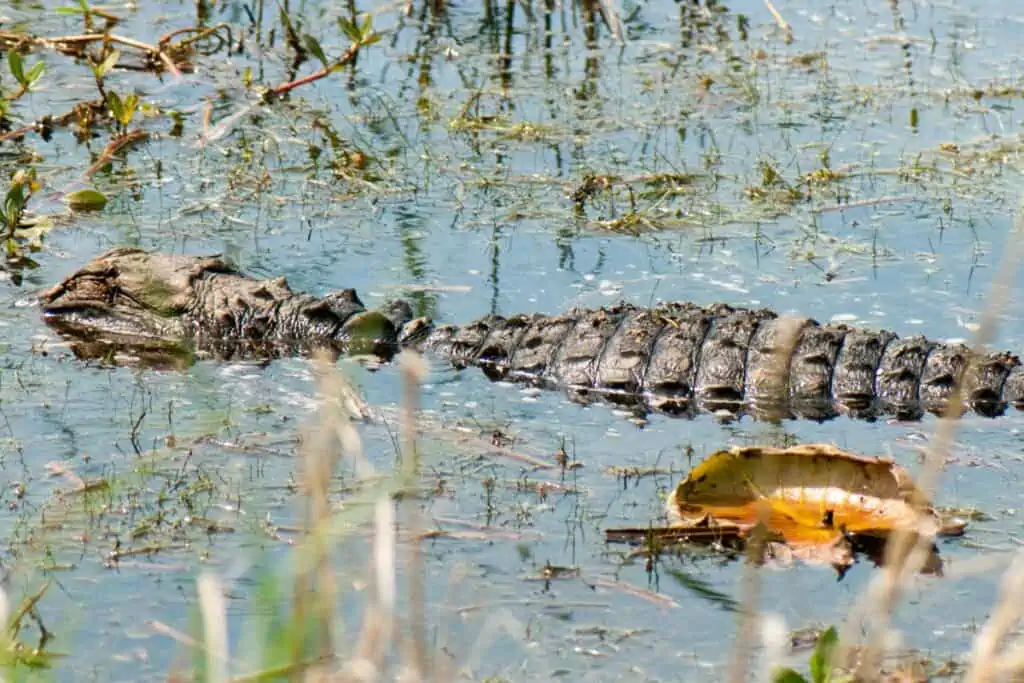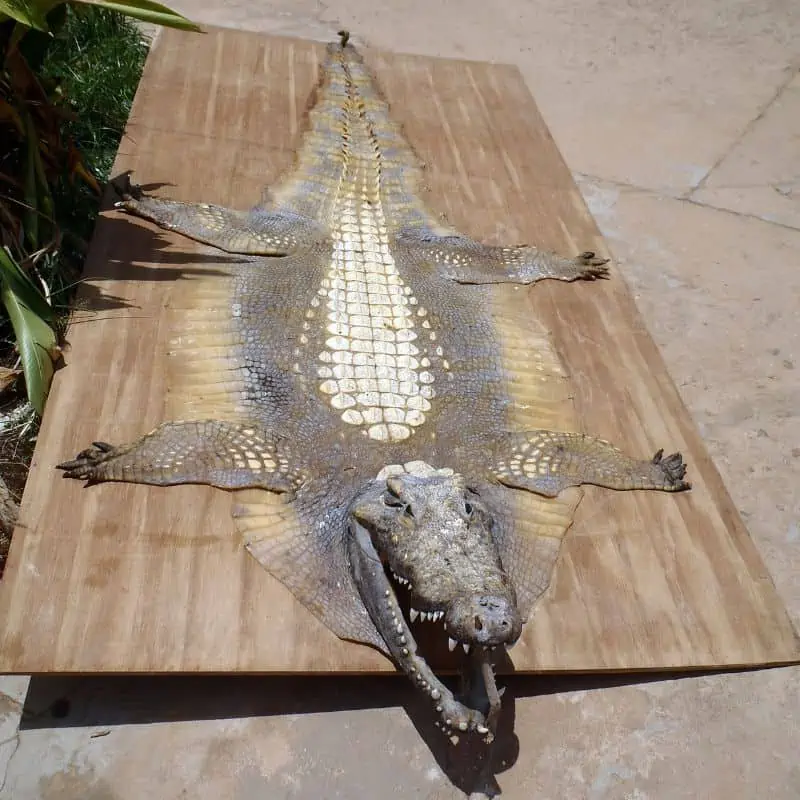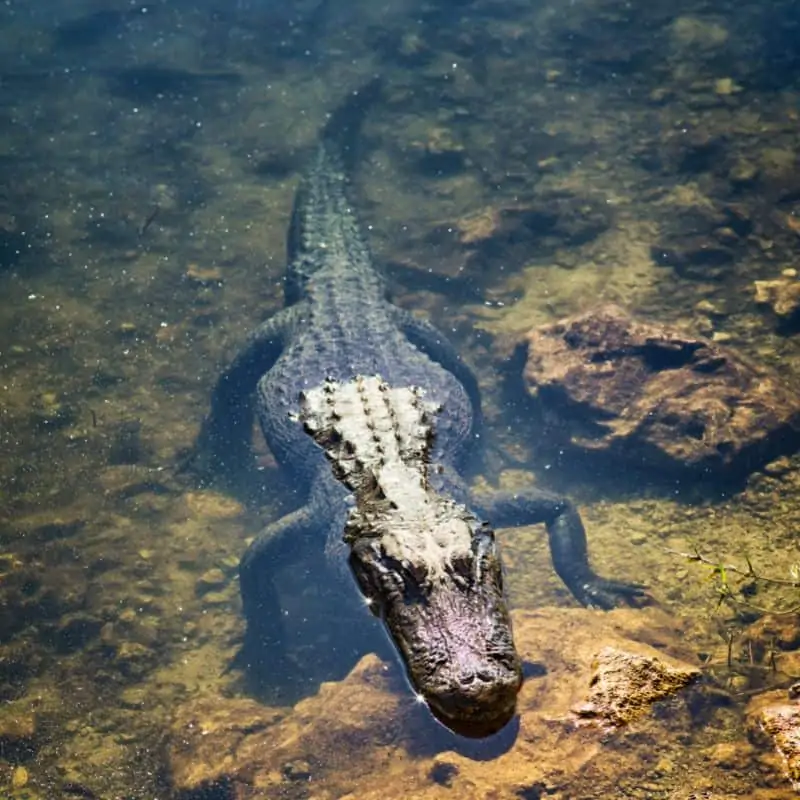The modern American alligator dates back to the Pleistocene Age and has evolved very slowly. Alligators are found only in China, Mexico, and the United States, but where in the USA exactly? Are there alligators in Georgia?
There are alligators in Georgia – about 200,000 to 250,000. Alligators inhabit the southeastern part of the US, mainly in Louisiana, Texas, Florida, Mississippi, and Georgia, with small populations in North and South Carolina, Alabama, and Arkansas. The total alligator population in the USA is around five million.
Louisiana has the largest alligator population, with around one million in the wild and another million raised on alligator farms.
Florida has about 1.25-million, Texas around 500,000, and only between 31,000 and 38,000 in Mississippi. But what about Georgia?

Where Are Alligators Found In Georgia?
Georgia’s geology is dominated by a fall line, which runs from the northwest to southeast of the state and was the prehistoric Atlantic Ocean shoreline about 50 million years ago.
We mention it because it separates Piedmont in the north from the coastal plain, and it’s the natural boundary of the alligator population of Georgia, which has, until very recently, existed only south of the fall line.
About 13,000 of Georgia’s alligators live in the Okefenokee Swamp, a 438,000-acre wetland straddling the Florida/Southern Georgia border.
But you can expect to find alligators in all the rivers, lakes, and wetland areas south of the fall line.
They prefer shallow swampy locations, but they have been found in golf course ponds and even swimming pools as they migrate from one place to another.
Lake Blackshear, in the heart of South Georgia, which is home to a state park, resort location, and golf course, is also home to an estimated 10,000 gators.
Alligators live in a freshwater environment, so the state’s alligator population, endangered in the 1950s and 1960s through indiscriminate hunting and changes in habitat, can now be found in most rivers, lakes, and backwater swamps.
Are Georgia’s Alligators Dangerous?
Although they are frightening to look at, alligators do not, as a rule, pose any danger to people.
Since 1980, Georgia has had only a single death and eight reported attacks. However, it is a wild creature and, if threatened, can be dangerous.
People are advised to keep their distance if they encounter an alligator, particularly if it is out of its normal habitat.
Alligator Farming in Georgia
Not all alligators in Georgia are wild. The state has ten registered alligator farms, where they are raised and slaughtered for their hides and meat, which are sold.
The biggest farm houses approximately 800 alligators at a time, so they account for only a small percentage of the total alligator population of Georgia.
Alligator Hunting In Georgia
The alligator numbers in Georgia reflect a good luck story, not only for the alligators but for the environment, as alligators play a vital role in the ecological balance of the state.
Numbers had been dropping steadily since the early 1900s due to unregulated hunting, and the alligator was listed as endangered in 1967.
This status, combined with strict law enforcement and proactive management by the wildlife authorities, stabilized the alligator population, and today there are sufficient numbers to make the controlled hunting of alligators possible.
The hunting season in Georgia is limited, opening in mid-August and closing at the beginning of October. A permit and a harvesting record are required to monitor the numbers, and each permit holder is allowed to “harvest” only one alligator.
To ensure that only adult alligators are caught, there is a minimum size of 48 inches stipulated in most areas and 96 inches in Lake Walter F. George.
Permits are allocated in specific hunting zones according to a fixed quota, so hunting is strictly controlled and monitored.
The alligators are hunted using hand-held ropes, snares, harpoons, and arrows with a restraining line attached. They must be “dispatched” immediately using a handgun or bang stick or by severing the spinal cord with a sharp instrument.
Once dispatched, there is a requirement that the alligator is tagged and details recorded before the carcass is skinned and meat harvested.

As a matter of interest, alligator meat is described as good quality, full of flavor, high in protein (twice as much as beef), and low in cholesterol.
However, wild alligator meat may contain high contaminant levels of mercury and should be avoided by children and pregnant women. This doesn’t apply to farmed alligator meat sold commercially and used in restaurants.
Nuisance Alligators In Georgia
Licensed trappers in Georgia are called in to remove alligators that are considered nuisances throughout the state:
- Because they have become over-familiar with humans and don’t move away or become aggressive
- Have been fed by people, intentionally or otherwise
- Have moved away from their natural habitat
Some Interesting Facts About Georgia’s Alligators
There’s not a lot of interaction between people and alligators, so the average visitor to, or resident of, Georgia may not be aware of some of the facts about alligators:
- Alligators, being apex predators in the food chain, play an important role in maintaining the balance of the environment they live in. The holes they dig in the wetlands to lay eggs in and the trails they make provide habitats for fish and marine life, allowing them to survive droughts and dry periods.
- They eat raccoons, who are known to prey on injured birds in particular, as well as eggs, and in this way, they protect bird life. Nesting birds know this protective behavior and accept the alligator’s presence.
- Alligators are naturally shy and will avoid contact with people if they can. However, predators kill smaller animals, such as raccoons and rabbits, fish, reptiles, and other amphibians. They’re efficient, waiting with only their eyes above water until some unsuspecting prey passes, and then they move very swiftly.
- They are primarily active between dusk and dawn, and while there have been almost no attacks on humans, people should avoid the shoreline of lakes and rivers at this time of day.
- Georgia is the state that has been most successful in growing its alligator population. In Florida, there has been little or no growth, although, with urban development, the alligator has been pushed out of its habitat and has become more visible. It is still an endangered species in North Carolina, Florida, and Oklahoma.
- The Everglades in Florida is the only place where the alligator and crocodile populations coexist.

Final Thoughts On Alligators In Georgia
While Louisiana, Florida, and Texas all have larger alligator populations, Georgia has been the most proactive in encouraging its alligator numbers’ growth.
While they only breed south of the fall line, alligators have even been found north of it, presumably transported by people to keep them in captivity.
Between 200,000 and 250,000, the alligator population in Georgia has stabilized to the point where controlled hunting is allowed.
They are spread over the entire area of South Georgia in lakes, rivers, and wetlands. With very few attacks on people, this prehistoric reptile is accepted and valued as part of the state’s ecology and has a secure future.
